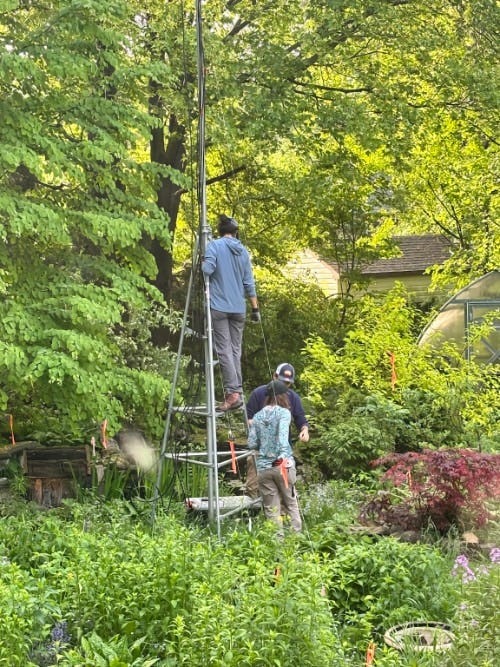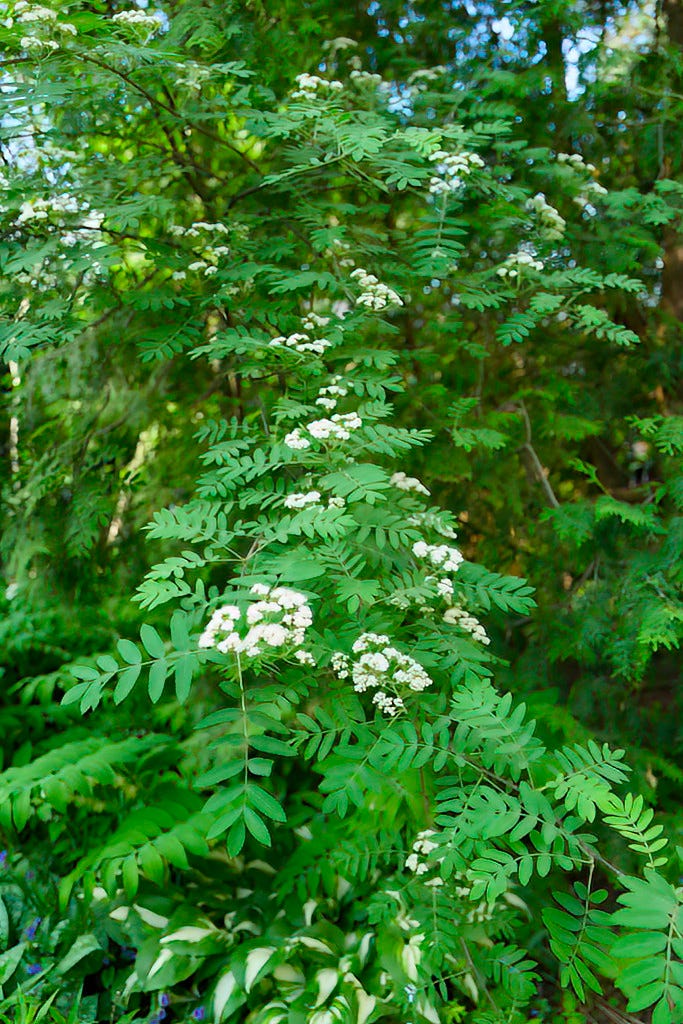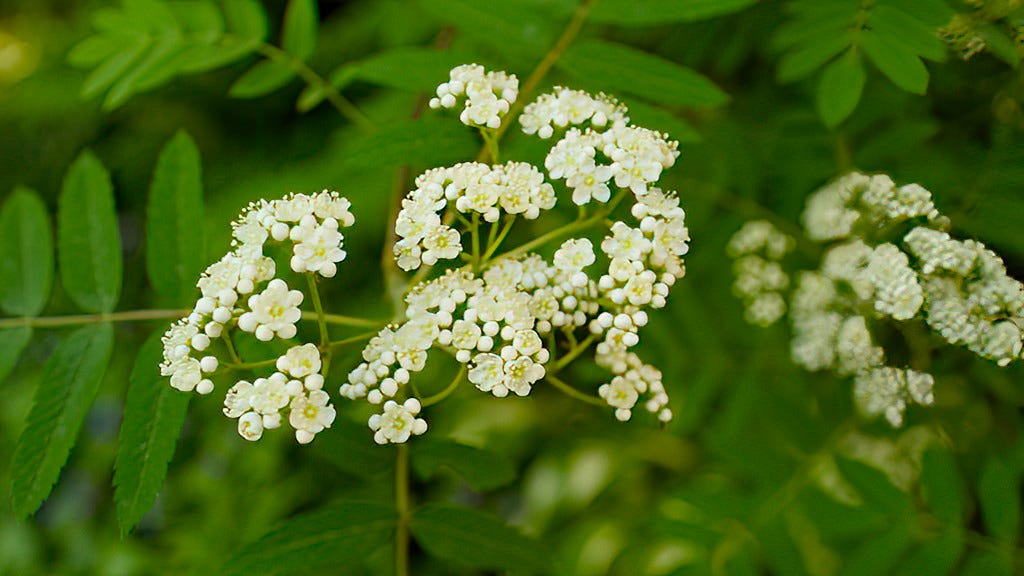Excess mowing
This article is from the UK but could probably be written about any country/city on earth. It is most dispiriting.
Quote: Systemic problems need systemic solutions. As a campaign to persuade individual homeowners to change how they garden, No Mow May is a charming but inherently limited initiative. However, as a tool to persuade not just individuals but public authorities to rethink their out-of-date intensive mowing and poison-spraying regimes, it can make a real impact on nature recovery
The Tower is Gone
Throughout the winter and spring there has been a >30 foot tall radio mast mounted in the garden. It was there as a part of a Masters student project (the McGill U environmental campus is just a short walk away) monitoring the distribution and movements of Northern Cardinals on the West Island. It’s been really interesting watching the dedicated student involved, and her colleagues, downloading data at -20C or colder 🙃 and to welcome birds with radio tags at our feeders. Earlier this week the tower was taken down and the garden is returned to normal as our collection of native plants almost visibly increase in height by the day.
Plants to Enjoy - in the wild and in our gardens
A good wildlife garden is more than just a corner of a garden left to go wild. Whether you are creating a new wildlife garden, or have an established one, think of it as a nature reserve and you as being the warden. It was with that in mind and with an eye to spreading information about the “1001 Species” to be found near our cities and suburbs that I started this newsletter but sometime, I admit, it has wandered somewhat from the “Species of the Week” concept it was supposed to encompass. A month ago, in mid-April, there was not much green around here above a couple of inches tall but now our plants are at least knee high and quite literally visibly taller by the day. This is going to be a fine year for the wildlife garden.
Here are three plants that are worthy of note this second half of May - do you have them in your garden or within a short walk in the neighbourhood?
Golden Alexander (Zizia aurea)
Finding this is two spots in the garden this year was a bit of a treat as had not planted it … arrived all by itself, aided by birds I imagine. It’s another umbelliferous relative of the wild carrot (Daucus carrota), poison hemlock and wild parsnip but without (most of) the irritating photosensitization attributes to its sap of the others. Host plant for Black Swallowtail butterfly caterpillars, while female mining bees (Andrena ziziae) eat only its pollen. In fact they almost eat no pollen other than from this species. Many other species of bees, flies, wasps, butterflies, and other insects visit the flowers for nectar. So this is very much a plant we want to establish and encourage - hopefully that won’t be a problem as it spreads rapidly by seed if the conditions are right. Flowers from May to June. It prefers wet and sometimes boggy habitat, but is apparently very tolerant of drought.
Rowan
Also known as Mountain Ash. There are several species of Sorbus spread around the northern hemisphere, all them related to roses. Extremely hardy.
The traditional name rowan was applied to the species Sorbus aucuparia. The name "rowan" is recorded from 1804, detached from an earlier rowan-tree, rountree, attested from the 1540s in northern dialects of English and Scots. It is often thought to be from a North Germanic source, perhaps related to Old Norse reynir, ultimately from the Germanic verb raud-inan "to redden", in reference to the berries. In the Canadian maritime provinces it is commonly referred to as a "dogberry" tree.
There is much folklore attached to the various Rowan species - including the knowledge that staffs made of Rowan wood are favoured by wizards for its supposed powers. In Scotland, the tree was often planted near a gate or front door as protection from witches.
Clusters of red Rowan berries form quite early in summer and are much favoured by birds of many species.
Fleabanes
This North American native plant (Erigeron philadelphicus is the commonest hereabouts of 170 species on this continent) grows almost rampantly in the garden. About two feet tall with small flowers - yet another of the many species of Asteraceae. Flowers are pollinated by a variety of bees and flies. Wasps, small butterflies and other insects also nectar on these plants.
Its common name, like those of other “-banes”—wolfsbane, dogbane, leopard’s bane, henbane—alludes to the folklore that they have the ability to kill or ward off pests. Historically, fleabane was burned or dried in sachets to repel fleas, gnats, flies, and all other manner of tiny, annoying creatures, though there is little evidence of its effectiveness as an insect repellent.
Provides nectar for various species of pollinators. The seeds are a favoured food snack for small finches and sparrows. .
We were in the local grocery store a couple of days ago, contemplating the (plastic!) boxes of organic strawberries, the text on the labels of which spoke of “berries”. My mind jumped back to distant student days and said “Hang on - strawberries surely are not actually berries so why do they say they are? Turns out my memory was correct … strawberries have their seeds on the outside, with each seed representing a separate fruit. Much the same for raspberries too. Botanically, they are aggregate accessory fruits, in which the fleshy part is derived not from the plant's ovaries but from the receptacle that holds the ovaries. Now you know 😉 and can enjoy them just the same as ever.










I love Rowan trees. There are two in the small communal garden near our house and the birds clearly enjoy the berries each winter. They seem to be doing a good job of keeping witches away too!
I just planted zizia to see how it does. The fleabane volunteers, but we have so much shade that it doesn't seem too aggressive--yet.
We have seen no witches, so I suppose I have rowan somewhere, but haven't seen it either.